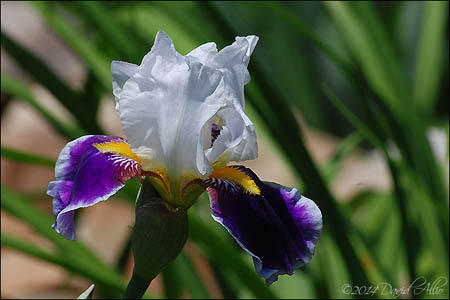
Iris germanica | ©2014 David Allio
It is mid-May and the Iris germanica from my mother’s collection is once again in full bloom and suitable for visual exploration. Botanically, an Iris is a perfect flower with three petals, trichrome yellow bearded sepals. Each year the question becomes, how to best showcase the purple, yellow, and white flower without presenting a simple still life cliche.
Participants in Experience Photography workshops have become familiar with my discourse on the creative significance of depth-of-field. Among other things, digital single lens reflex (DSLR) cameras are adjustable to allow the creative control of exposure and depth-of-field. Unfortunately, this less-understood or misunderstood aspect of photography is applicable to every aspect of that visual art.
Non-adjustable cameras – such as point-and-shoot, disposable, and camera phones – do not provide for the creative use of depth of field. The lens aperture, lens focal length, and distance to subject all affect the depth-of-field. Non-adjustable cameras deny the use of one or more of these tools and thereby reduce the creative control provided to the photographer.
As a photographer, if you cannot discern the difference between the top and bottom photograph, then depth-of-field may be of no concern. If you do not care to know the difference then, based on current technology, you should not be considered as a serious participant in that visual art.

Iris germanica | ©2014 David Allio
camera: Nikon D60 | lens: AF VR Nikkor Zoom 55-200mm f/4-5.6G IF-ED | focal length: 200mm
top photo exposure: f/8 – 1/1600th – ISO 400
bottom photo exposure: f/16 – 1/400th – ISO 400
You must be logged in to post a comment.